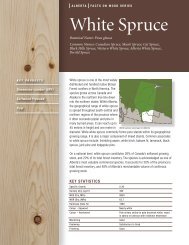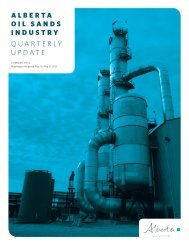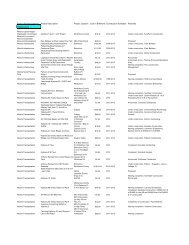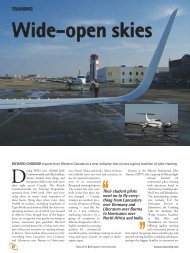Oil Sands Quarterly Winter 2013 - Alberta, Canada
Oil Sands Quarterly Winter 2013 - Alberta, Canada
Oil Sands Quarterly Winter 2013 - Alberta, Canada
Create successful ePaper yourself
Turn your PDF publications into a flip-book with our unique Google optimized e-Paper software.
2 ALBERTA OIL SANDS INDUSTRY QUARTERLY UPDATE<br />
All about<br />
the oil sands<br />
Background of an<br />
important global resource<br />
TABLE OF CONTENTS<br />
02<br />
03<br />
04<br />
06<br />
09<br />
15<br />
All about the oil sands<br />
Mapping the oil sands<br />
Government update<br />
NEWS:<br />
What’s new in the oil sands<br />
Project listings<br />
Glossary of oil sands terms<br />
Unless otherwise stated, all photos copyright<br />
JuneWarren-Nickle’s Energy Group © 2012<br />
<strong>Canada</strong> has the third-largest oil<br />
reserves in the world, after Saudi<br />
Arabia and Venezuela. Of <strong>Canada</strong>’s<br />
174 billion barrels of oil reserves,<br />
170 billion barrels are located in<br />
<strong>Alberta</strong>, and about 169 billion barrels<br />
are recoverable from bitumen.<br />
This is a resource that has been<br />
developed for decades but is now<br />
gaining increased global attention<br />
as conventional supplies—so-called<br />
“easy” oil—continue to be depleted.<br />
The figure of 169 billion barrels<br />
of bitumen represents what is<br />
considered economically recoverable<br />
with today’s technology, but with new<br />
technologies, this reserve estimate<br />
could be significantly increased. In<br />
fact, total oil sands reserves in place<br />
are estimated at 1.8 trillion barrels.<br />
There are three major bitumen<br />
(or oil sands) deposits in <strong>Alberta</strong>.<br />
The largest is the Athabasca<br />
deposit, which is located in the<br />
province’s northeast in the Regional<br />
Municipality of Wood Buffalo.<br />
The main population centre of the<br />
Athabasca deposit is Fort McMurray.<br />
The second-largest oil sands deposit<br />
is referred to as Cold Lake, just<br />
south of Athabasca, with the main<br />
population centre the City of Cold<br />
Lake. The smallest oil sands deposit<br />
is known as Peace River, which is<br />
located in northwest-central <strong>Alberta</strong>.<br />
A fourth deposit called Wabasca links<br />
to the Athabasca and is generally<br />
lumped in with that area.<br />
The existence of bitumen in <strong>Alberta</strong><br />
has been known for a long time.<br />
The first mention of it in Canadian<br />
history was in 1719, when a Cree<br />
named Wapasu brought a sample of<br />
the “gum” to a Hudson’s Bay trading<br />
post. First Nations in what is now the<br />
Wood Buffalo area had traditionally<br />
used the bitumen, which seeps from<br />
outcrops along the Athabasca River,<br />
to waterproof their canoes.<br />
Today, bitumen is produced as an<br />
energy source by two means—mining<br />
and in situ. In 2011, 51 per cent of oil<br />
sands production came from mines,<br />
but by 2015, in situ bitumen production<br />
is expected to surpass mined bitumen<br />
production. <strong>Alberta</strong> will need to rely to<br />
a greater extent on in situ production<br />
in the future, as 80 per cent of the<br />
province’s proven bitumen reserves are<br />
too deep underground to recover using<br />
mining methods.<br />
There are essentially two commercial<br />
methods of in situ (Latin for “in<br />
place,” essentially meaning wells are<br />
used rather than trucks and shovels).<br />
In cyclic steam stimulation (CSS),<br />
high-pressure steam is injected into<br />
directional wells drilled from pads<br />
for a period of time, then the steam<br />
is left to soak in the reservoir for a<br />
period, melting the bitumen, and<br />
then the same wells are switched<br />
into production mode, bringing the<br />
bitumen to the surface.<br />
In steam assisted gravity drainage<br />
(SAGD), parallel horizontal well pairs<br />
are drilled from well pads at the<br />
surface. One is drilled near the top of<br />
the target reservoir, while the other<br />
is drilled near its bottom. Steam is<br />
injected into the top well, a steam<br />
chamber forms, and the melted<br />
bitumen flows into the lower well via<br />
gravity and is pumped to the surface<br />
using artificial lift.<br />
Both SAGD and CSS are used in<br />
the Cold Lake and Peace River<br />
deposits, while SAGD is the in<br />
situ technology of choice in the<br />
Athabasca deposit. The selection<br />
is based on a number of factors,<br />
including geology. The technologies<br />
combined currently produce just<br />
over one million barrels per day.<br />
Research is underway on a number<br />
of other production technologies<br />
designed to optimize production,<br />
including variations on solvent-assisted<br />
SAGD and CSS, recovery using<br />
electricity, and in situ combustion.<br />
Bitumen that has not been processed,<br />
or “upgraded,” can be used directly<br />
as asphalt. It must be diluted to travel<br />
by pipeline. Adding value, some<br />
producers upgrade their product<br />
into synthetic crude oil, which is<br />
a refinery feedstock. That can be<br />
transformed into transportation fuels<br />
and other products. ■











